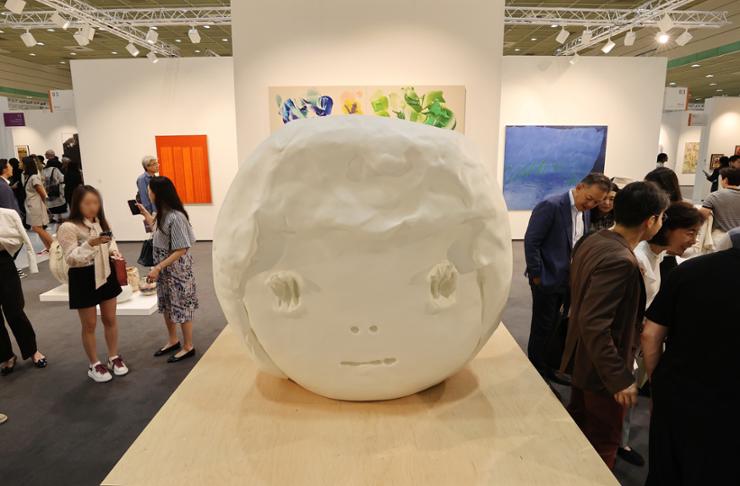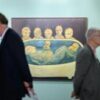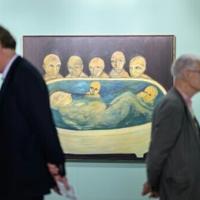
Visitors take a look around blue-chip dealer Blum’s booth during a VIP preview of Frieze Seoul 2024 at COEX in southern Seoul, Wednesday. Yonhap
In Korea, a wet monsoon in the summer is followed by another kind of downpour in the fall — a deluge of art.
September ushers in a season where the country is swept up in a whirlwind of art exhibitions and two major biennales, all coinciding with the return of Frieze Seoul.
Now in its third iteration, the four-day mega-fair landed at COEX in Gangnam District, Seoul, Wednesday, drawing 117 galleries from 32 countries and throngs of art lovers from around the world.
High-profile attendees ranged from Hans Ulrich Obrist, artistic director at London’s Serpentine Galleries, to Kim Woong-ki of Global Sae-A Group, the owner of Kim Whanki’s “Universe 5-IV-71 #200,” the most expensive Korean artwork ever auctioned.
This year, the event has doubled down on its focus on Asia-based exhibitors, with 64 percent of the participants operating in or having a presence in the region.
Despite reporting notably lower sales compared to previous editions, many international blue-chip dealers with spaces in Seoul emphasized their fruitful engagement with the Korean art community beyond the fair itself, demonstrating that their participation extends beyond mere transactions.
“Frieze is a smaller component for us this week, as we have put much of our attention to our Seoul space’s exhibition and the museum shows of our artists,” Pace Gallery’s CEO Marc Glimcher told The Korea Times.
He was referring to the gallery’s headline exhibition, “Correspondence: Lee Ufan and Mark Rothko,” at its Seoul location, as well as two museum shows featuring its artists: the Scandinavian duo Elmgreen & Dragset at the Amorepacific Museum of Art and Kylie Manning at Space K.
“The fair is really to highlight these,” he added.
By the end of the VIP preview day, the exhibitor reported sales including a small-scale polished bronze “Love” sculpture by Robert Indiana for $550,000 (737 million won) and a new figurative painting by Manning for $100,000.
A day before Frieze Seoul opened, powerhouse dealer Thaddaeus Ropac announced that Lee Kang-so, regarded as one of Korea’s foremost experimental artists, has joined its roster. The gallery also represents emerging Korean abstractionist Chung Hee-min.
“Since we opened our space [in Yongsan District], on the one hand, we’ve focused on bringing European artists to Korea, but on the other hand, we wanted to really engage with the art world here. So every time I come here, I visit artist studios. That was how I met artists like Chung,” the Austrian gallerist said.
Chung will have her first European show at the exhibitor’s London outpost this October in time for Frieze London.
“As for Lee Kang-so, he was one of the artists that always felt a bit underappreciated internationally,” Ropac continued. “His work spans performance, installations, paintings and sculptures. The huge variety of his work aligns well with Joseph Beuys, who really marks the start of our program in Europe, and what he was doing in the late 1960s and the ‘70s. Lee felt like a natural fit for our program.”
One of the standouts at the booth of Paris-headquartered Perrotin, which operates a space in Gangnam District, is a striking red silk painting by rising London-based Korean artist Kim Hun-kyu, created specifically for Frieze Seoul.
Drawing inspiration from classical Buddhist painting techniques, the artist fills his canvases with a dizzying array of animated characters and objects, all rendered in traditional Korean pigments.
While the gallery has been spotlighting veteran Korean artists over the years — such as “dansaekhwa” (monochrome painting) master Park Seo-bo and sculptor Shim Moon-seop — this collaboration with an emerging talent signals another direction in its expanded approach to discover the country’s creatives, the exhibitor noted.
This year’s Frieze Masters section, dedicated to art from the Middle Ages to 20th-century masterpieces, has invited a number of galleries showing historical Asian art.
Asia Art Center, based in Taipei and Beijing, has devoted its booth to a solo presentation of Taiwan’s most celebrated sculptor Ju Ming. The display features an array of copper sculptures from his signature “Tai Chi Series” — boxy metal pieces in dynamic postures inspired by the martial art.
“I think this is a great chance for galleries and collectors to see more master artists from Asia, because it’s really a rare opportunity we can promote these figures in an international fair,” said Harvey Liu, the gallery’s senior marketing and sales specialist.
Unlike participation in events like Frieze New York or Art Basel in Basel, which often entails hefty shipping and operational costs for Asian galleries, Frieze Seoul provides an opportunity to globally spotlight regional masters closer to home, he added.
This post was originally published on this site be sure to check out more of their content



![[PHOTOS] Frieze Seoul matures into third year](https://img.koreatimes.co.kr/upload/thumbnailV2/493a40a6cdaf4a82a66c914945f934f5.png/dims/resize/84/optimize)


